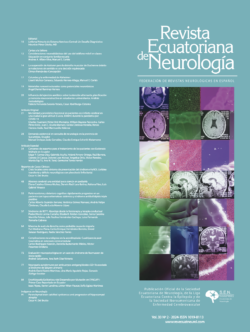Artículo original
Alta viscosidad sanguínea en pacientes con Ictus Isquémico que residen a gran altitud. High blood viscosity in patients with ischemic stroke residing at high altitude.
Autor: Charles Huamaní, Víctor Oré-Montalvo, William Bayona-Pancorbo, Carlos Pérez-Alviz, Juan C. Acuña-Mamani, Golda Córdova-Heredia, Renzo Herrera-Aedo, Raúl Marmanillo-Valenza, Franklin Miranda-Solis, Luis Pacheco-OtárolaRev. Ecuat. Neurol. VOL 33 Nº1, 2024
Introducción: Los factores de riesgo de ictus isquémico han sido ampliamente estudiados. Sin embargo, se han realizado pocos estudios en poblaciones que residen en ciudades de gran altitud. Nuestro objetivo es evaluar la asociación entre la viscosidad sanguínea y el ictus isquémico en pacientes residentes en altura e identificar el subtipo de ictus isquémico más frecuente entre estos pacientes.
Métodos: Estudio observacional y analítico que se realizó en un hospital en Cusco, Perú (3399 m) e incluyó pacientes con y sin ictus. La viscosidad de la sangre (en centipoises [cP]) se midió utilizando un viscosímetro de cono/placa.
Resultados: Se incluyeron un total de 386 pacientes, de los cuales 141 (36,5%) presentaron ictus. La mediana de edad fue de 67 años (RIC 52-80), y 165 (42,7%) pacientes eran mujeres. La viscosidad sanguínea fue significativamente mayor en el grupo de ictus isquémico (5,9 cP; RIC, 5,2–6,8) que en el grupo sin ictus (5,5 cP; RIC, 4,9–6,1; p<0,001). Un aumento de la viscosidad de la sangre se asoció con un mayor riesgo de sufrir un accidente cerebrovascular isquémico (OR 1,40; intervalo de confianza del 95%, 1,16–1,69; p<0,001). Los pacientes con ictus por oclusión de vasos pequeños tenían la mayor viscosidad sanguínea (6,1 cP; RIC, 5,8-6,3).
Conclusiones: Los pacientes con ictus isquémico que residen en grandes alturas tienen una mayor viscosidad sanguínea que los pacientes sin ictus, aunque el subtipo de oclusión de pequeño vaso se corresponde con la mayor viscosidad sanguínea.
Introduction: Risk factors for ischemic stroke have been extensively studied. However, few studies have been conducted in populations residing in high-altitude cities, where acclimatization processes cause elevations in blood viscosity. Our objective is to evaluate the association between blood viscosity and ischemic stroke in patients residing at altitude and to identify the most frequent subtype of ischemic stroke among these patients.
Methods: This case-control study was conducted in a hospital in Cusco, Peru (3,399 m) and included patients with and without ischemic stroke. Patients were included in the ischemic stroke group (cases) after having had up to three days of confirmed illness. The control group comprised patients hospitalized for other causes. Blood viscosity (in centipoise [cP]) was measured using a cone/plate viscometer. Viscosity data are reported as medians with interquartile ranges (IQR), and associations were evaluated using logistic regression with odds ratios (OR).
Results: A total of 386 patients were included, of which 141 (36.5%) had ischemic stroke. The median age was 67 years (IQR 52-80), and 165 (42.7%) patients were women. Blood viscosity was significantly higher in the ischemic stroke group (5.9 cP; IQR, 5.2–6.8) than in the control group (5.5 cP; IQR, 4.9–6.1; p<0.001). An increase in blood viscosity (in 1 cP increments) was associated with an increased risk of developing ischemic stroke (OR 1.40; 95% confidence interval, 1.16–1.69; p<0.001). Patients with the small-vessel occlusion subtype had the highest blood viscosity (6.1 cP; IQR, 5.8–6.3), which was significantly higher than in patients without stroke (p=0.002) or with other ischemic stroke subtypes (p=0.03).
Conclusions: Patients with ischemic stroke residing at high altitudes have higher blood viscosity than control patients regardless of ischemic stroke subtype, although the small-vessel occlusion subtype corresponded with the highest blood viscosity.





